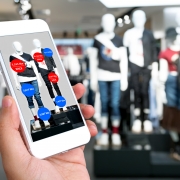Retail Technology Trends in 2020
With only 29 shopping days left until Christmas Day, consumers are buying at brick-and-mortar stores, but still do most of their product research online. Moving into 2020, retailers have the opportunity to go a step further and leverage data-driven and digital technologies to elevate the customer experience in more meaningful ways.
Today’s shoppers prioritize exceptional customer experience. They’re willing to provide their data to companies, but expect a higher quality experience in return. For retailers and their brands, this means delivering on the promise of personalization, expert service, always-available inventory and seamless cross-channel shopping. By enabling comprehensive shopping journeys, customers can also feel that their relationships with brand and retailers is authentic.
So what is the future of retail? How do you connect with consumers to drive your retail business? As consumer behavior is changing, new retail technologies are developing in the industry landscape. If you aim to stay at the forefront of retail technology trends in 2020 (which you should be), here’s the industry vision on what to expect from technology in the upcoming year.
Make it Personal
Personalizing the customer experience can allow brands to win big, even if retail sales have been declining. According to a Salesforce study, 51% of consumers expect that companies will anticipate their needs and make relevant suggestions before they even make contact — all by 2020! Three key ways retailers can tap into this trend include:
- Create A Personal Connection With Your Consumers: In order to be successful with personalization, companies needs to create a connection with customers that goes far beyond generic marketing. And that applies across most industries, whether it be apparel, travel, or electronics, both online and offline.
- Make Your Customer Feel Psychologically Connected: Customers don’t just want to be aesthetically or practically attracted to your brand. They want to feel like they have a shared sense of beliefs and morals. Trying to reach your customer through a generic “50% Off Sale” is unsustainable and will not lead to customer loyalty. A personal connection, however, will.
- Create Entertaining Experiences: The entertainment industry is booming even while the retail industry falters. That’s because consumers are always attracted to fun experiences. Shopping shouldn’t just feel like shopping, it needs to feel like an experience, which is where harnessing new technology comes into play…
Augmented Reality (AR)
Advances in VR, AR, and AI lead to this new wave of personalized entertainment. 2020 will be the year where it is virtually unnecessary to see, feel, or test a product in person before you feel confident enough to buy it, thanks to augmented reality.
Toyota recently launched a new AR program that allows users to try out 10 of their cars without ever picking up the keys. Other companies like Target, Lowe’s and Amazon have found that augmented reality may be especially helpful in decreasing the number of returns they see from online shoppers. Indeed, while e-tail will hit $5 billion in value by 2021, it is estimated that 25% of purchased items are sent back. According to BRP, nearly 50% of shoppers (link is external) would buy from a retailer that provides AR/VR experiences.
AR could also mean retailers keep more of their sales because consumers more fully understand what they’re buying at point of purchase. Technology in this area is also catching up as companies like Microsoft launch second generation augmented reality headsets, which is one of many newer, lighter headsets and wearables that will make AR more immersive for retail customers and employees.
Predictive Analytics (Big Data)
Retail organizations have never had an issue collecting lots of data, but analyzing it and using the data to solve problems or create new solutions has been a struggle. Predictive analytics changes that. Now retailers can be proactive about the future by analyzing consumer behavior and trends from the past. When retailers successfully analyze data, they are able to understand important information about consumer purchasing behavior, improve efficiencies and reduce costs of supply chains and more.
For the retail industry, which leverages point-of-sale transaction-level data, store size, demographics, social media metrics, competitive intelligence and many other data points, this can have a significant impact on their bottom line.
Customer Experience Research
In the retail sector, consumers are loyal to brands that consistently provide the right experience that provide an element of human touch. The solution: retail companies are funneling more of their investments and resources into creating the best experience they can for people through customer research. Retail customer research provides critical insights into shoppers’ changing habits and attitudes. Ways to harness useful customer experience research includes:
- Mystery Visits: Mystery Shopping is a well-known method of customer research. Using calls, clicks or visits, secret shoppers follow predefined scenarios and record their experience at various touch points throughout the customer journey.
- QA and Brand Audits: Your company spends a big chunk of the budget on promotions and pricing strategies. Are you monitoring them to make sure they are being executed correctly? 79% of consumers say being able to engage with knowledgeable store associates is “important” or “very important” (Tulip Research Survey). Audits can be executed covertly without your staff being aware that the audit is taking place, or as an in-depth announced audit. Discover if your desired brand image is being represented the way you envisioned or evaluate your employees to improve training and reward top performers.
- Customer Surveys: Want to know how your customer’s experience was? Ask them. Customer Satisfaction (CSAT) Surveys provide you instant results, unlimited feedback, and allow for customer incentives in exchange for completing surveys. These surveys are cost-effective and user friendly. Surveys can be even conducted via mobile or computer, with QR codes or kiosk links.
Final Thoughts
Retail innovation is happening fast and furious today, and it’s central to the conversation around the stores of tomorrow. From developing new takes on established retail models to designing strategies to center the buying process around customer experience, retailers are experimenting, evolving and envisioning a wide array of possibilities.
While these new technologies will certainly be part of the overall retail landscape in 2020, they are all available today. In fact, today’s most innovative retailers are already successfully deploying these cutting-edge technologies to increase employee engagement and productivity, manage their business better, and ultimately, drive revenues and profits higher.











